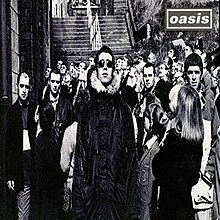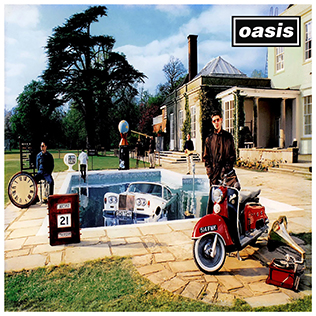
Be Here Now is the third studio album by the English rock band Oasis, released on 21 August 1997 by Creation Records. The album was recorded at multiple recording studios in London, including Abbey Road Studios, as well as Ridge Farm Studio in Surrey. Although most tracks retain the anthemic quality of previous releases, the songs on Be Here Now are longer and contain many guitar overdubs. Noel Gallagher said this was done to make the album sound as "colossal" as possible. The album cover features a shot of the band members at Stocks House in Hertfordshire. It is the last Oasis studio album to feature founding members guitarist Paul "Bonehead" Arthurs and bassist Paul "Guigsy" McGuigan as the two left in 1999.
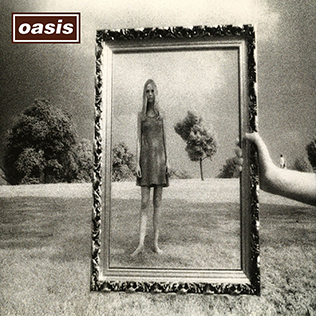
"Wonderwall" is a song by English rock band Oasis, written by lead guitarist and chief songwriter Noel Gallagher. The song was produced by Gallagher and Owen Morris for the band's second studio album, (What's the Story) Morning Glory?, released in 1995. According to Gallagher, "Wonderwall" describes "an imaginary friend who's gonna come and save you from yourself".
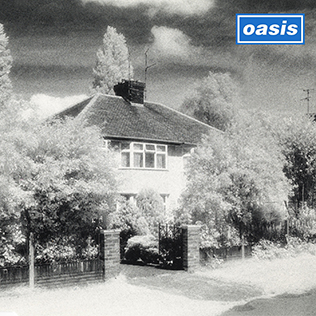
"Live Forever" is a song by English rock band Oasis. Written by Noel Gallagher, the song was released as the third single from their debut album Definitely Maybe (1994) on 8 August 1994, just prior to that album's release. Gallagher wrote the song in 1991, before he joined Oasis.
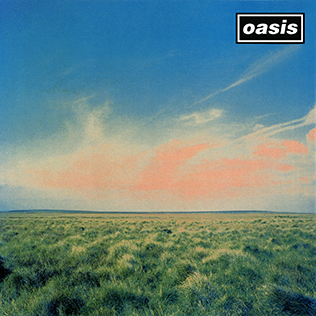
"Whatever" is a song by the English rock band Oasis. Written by the band's lead guitarist, Noel Gallagher, it was released on 18 December 1994 by Creation as the band's first non-album single. A subsequent lawsuit awarded a co-writing credit to Neil Innes.

"Cigarettes & Alcohol" is a song by English rock band Oasis, written by Noel Gallagher. It was released on 10 October 1994 as the fourth and final single from their debut album Definitely Maybe (1994), and their second to enter the UK top ten in the United Kingdom, peaking at number 7, eventually spending 79 weeks on the charts. On 13 March 2020, nearly 26 years after its release, the song was certified Platinum, indicating 600,000 sales.

"Supersonic" is a song by English rock band Oasis, released as their debut single on 11 April 1994, and later appeared on their debut studio album, Definitely Maybe (1994). It was produced by the band and Mark Coyle, their live sound engineer. The single was accompanied by two music videos, one directed by Mark Szaszy and the other by Nick Egan.
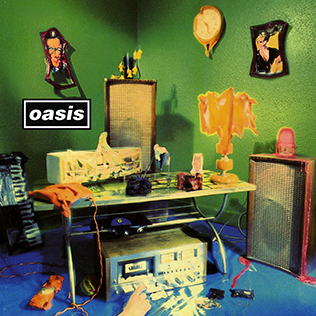
"Shakermaker" is a song by the English rock band Oasis. It was written by lead guitarist Noel Gallagher. The song was first released as a second single on 20 June 1994 and later released on Oasis' debut album Definitely Maybe (1994). The single peaked at number eleven in the UK. It was certified silver by the British Phonographic Industry in 2013, having previously been their only single of the 1990s not to be certified in the UK. As of 2021, it remains the only single from the band's first two albums not to reach at least platinum status in the UK.

"Some Might Say" is a song by the English rock band Oasis. It was released as the first single on 24 April 1995 by Creation from their second studio album, (What's the Story) Morning Glory? (1995). The song was written by the band's lead guitarist Noel Gallagher. "Some Might Say" provided Oasis with their first number one on the UK Singles Chart and reached the top 10 in Finland, Iceland, Ireland and Sweden. The song is also the last to feature all five original members, as the drummer Tony McCarroll was fired shortly after the song's release.

"Roll with It" is a song by English rock band Oasis, written by lead guitarist Noel Gallagher. It was released on 14 August 1995 by Creation as the second single from their second studio album, (What's the Story) Morning Glory? (1995). In a highly publicised chart battle with Blur's single "Country House" dubbed "The Battle of Britpop," "Roll with It" reached number two on the UK singles chart.

"Don't Go Away" is a song by English rock band Oasis from their third album, Be Here Now (1997). Written by Noel Gallagher, the song was released as a commercial single only in Japan, peaking at number 48 on the Oricon chart, and as a promotional single in the United States and Canada. The track reached number 35 on the US Billboard Hot 100 Airplay chart and number 15 on the Canadian RPM 100 Hit Tracks chart in late 1997.
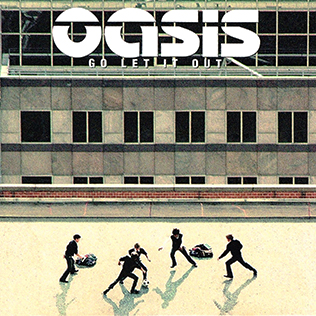
"Go Let It Out" is a song by English rock band Oasis, written by the band's lead guitarist, and chief songwriter, Noel Gallagher. It was released on 7 February 2000 as the first single from their fourth studio album, Standing on the Shoulder of Giants (2000), as well as their first following the departure of rhythm guitarist Bonehead and bassist Guigsy. The song peaked at number one on the UK Singles Chart and was later certified Gold for sales and streams exceeding 400,000. It also reached number one in Ireland, Italy, and Spain, as well as on the Canadian Singles Chart.

"Stand by Me" is a song by the English rock band Oasis, written by lead guitarist, Noel Gallagher. It was released on 22 September 1997 as the second single from the band's third studio album, Be Here Now (1997).
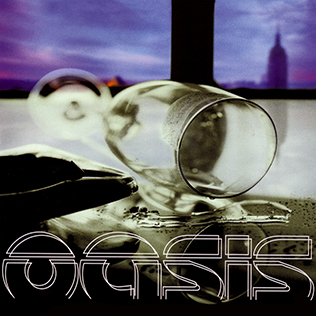
"Sunday Morning Call" is a song by the English rock band Oasis, released as the third and final single from their fourth studio album, Standing on the Shoulder of Giants. It reached number four on the UK Singles Chart, number five in Italy, and number 20 in Ireland.

"All Around the World" is a song by the English rock band Oasis. It was written by the band's lead guitarist and principal songwriter Noel Gallagher. Released on 12 January 1998 as the third single from their third studio album, Be Here Now (1997), it is the longest song ever recorded by Oasis. The song peaked at number one on the UK Singles Chart, becoming the longest song ever to reach number one, and earned a Gold certification. This was the last Oasis single to be released on the Creation Records label. The song also reached number one in Ireland and peaked at number 15 on the US Billboard Modern Rock Tracks chart.

"The Importance of Being Idle" is a song by English rock band Oasis. It was released on 22 August 2005 in the UK as the second single from their sixth studio album, Don't Believe the Truth (2005), written, produced, and sung by lead guitarist Noel Gallagher. The song was written by Gallagher in the mid-2004, before the band made their final attempt at recording what would become Don't Believe the Truth.

"Morning Glory" is a song by the English rock band Oasis, written by Noel Gallagher and released on the band's second album (What's the Story) Morning Glory? in September 1995. It was given a commercial single release only in Australia, New Zealand, and Japan, and it was also a radio single in the United States and Canada. In North America, it was the first song of the album to receive significant airplay, although primarily at alternative rock radio stations, as "Some Might Say" and "Roll with It" had not achieved as such.

"Champagne Supernova" is a song by English rock band Oasis, written by Noel Gallagher. It is the closing track on the band's second studio album, (What's the Story) Morning Glory? (1995), and was released as the sixth and final single from the album in Australia and New Zealand on 13 May 1996 by Helter Skelter. Paul Weller appears as a guest guitarist and backing vocalist on the track. A music video for the song, directed by Nigel Dick, was released in 1996. The single was not released in the UK.

The discography of the English rock band Oasis consists of seven studio albums, two live albums, five compilation albums, six video albums, one extended play, twenty seven singles which includes one double single, nineteen promotional singles and thirty-six music videos. As of 2024 the band have sold 75 million records worldwide, and been cited by Guinness World Records as the most successful act in the United Kingdom between the years 1995 and 2005. Oasis had 22 consecutive UK top 10 hits between 1994 and 2008. Oasis was formed in 1991 by vocalist Liam Gallagher, guitarist Paul "Bonehead" Arthurs, bassist Paul "Guigsy" McGuigan and drummer Tony McCarroll – they were later joined by guitarist and songwriter Noel Gallagher. The band signed to Creation Records in May 1993 and released their debut single "Supersonic" the following year; it peaked at number 31 in the United Kingdom. Follow-up singles "Shakermaker" and "Live Forever" became UK top 15 hits, with the latter also attaining success in the United States. Definitely Maybe, the band's debut studio album, topped the UK Albums Chart and went on to be certified eight times platinum by the British Phonographic Industry (BPI).

Stop the Clocks is a compilation album by English rock band Oasis. It was released on 20 November 2006 by Big Brother Recordings. The "retrospective collection" is an 18-track double album with the featured songs chosen by Noel Gallagher. It was certified 5× Platinum in the United Kingdom.

"Don't Look Back in Anger" is a song by English rock band Oasis. It was written by the band's lead guitarist and chief songwriter Noel Gallagher, and produced by Gallagher and Owen Morris. Released on 19 February 1996 by Creation as the fifth single from their second studio album, (What's the Story) Morning Glory? (1995), it became Oasis's second single to reach number one on the UK Singles Chart, earning a quintuple-platinum sales certification in the UK. It was the first Oasis single with lead vocals by Noel, who had previously only sung lead on B-sides, instead of his brother Liam. Noel would later sing lead vocals on six other singles. The music video was directed by Nigel Dick, featuring the band performing at a mansion where a large group of women appears.
